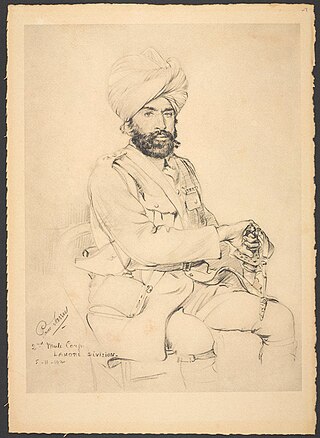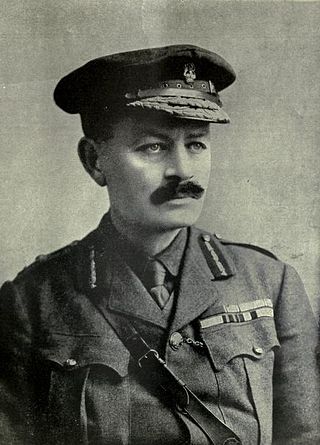
The Raid on the Suez Canal, also known as Actions on the Suez Canal, took place between 26 January and 4 February 1915 when a German-led Ottoman Army force advanced from Southern Palestine to attack the British Empire-protected Suez Canal, marking the beginning of the Sinai and Palestine Campaign (1915–1918) of World War I (1914–1918).
The 10th Indian Division was an infantry division of the British Indian Army during World War I. It was formed in Egypt in December 1914 with three infantry brigades of Indian Expeditionary Force F. After taking part in the Actions on the Suez Canal, the division was dispersed as its brigades were posted away.

The Indian Army, also called the British Indian Army, was involved in World War I as part of the British Empire. Almost 1.5 million Indian troops served overseas, of whom 62,000 died and another 67,000 were wounded. In total at least 74,187 Indian soldiers died during the war.

The 7th (Meerut) Division was an infantry division of the Indian Army and before 1895, the Bengal Army, that saw active service during World War I.

The 3rd (Lahore) Division was an infantry division of the Indian Army and before 1895, the Bengal Army, first organised in 1852. It saw service during World War I as part of the Indian Corps in France before being moved to the Middle East where it fought against troops of the Ottoman Empire.
The 11th Indian Division was an infantry division of the British Indian Army during World War I. It was formed in December 1914 with two infantry brigades already in Egypt and a third formed in January 1915. After taking part in the Actions on the Suez Canal, the division was dispersed as its brigades were posted away.
Indian Army during World War I order of battle
The 135th Infantry Brigade was an infantry brigade of the Territorial Force, part of the British Army. It was formed in the First World War as a duplicate of the South Western Brigade and was originally formed as the 2nd/1st South Western Brigade in 1914–1915 before later being renamed as the 135th Brigade. It was sent overseas to India in December 1914 to relieve Regular Army units for service in France. The brigade remained there for the rest of the war, supplying drafts of replacements to the British units fighting in the Middle East and later complete battalions.
The 11th Gurkha Rifles was a Gurkha regiment of the British Indian Army. It was formed in Mesopotamia and Palestine in May 1918, saw active service in the First World War and the Third Anglo-Afghan War, and was disbanded in April 1922.
The 5th (Mhow) Cavalry Brigade was a cavalry brigade of the British Indian Army that saw active service in the Indian Army during the First World War. Formed in November 1914, it served on the Western Front as part of the 2nd and 1st Indian Cavalry Divisions until it was broken up in March 1918.

The 6th Indian Cavalry Brigade was a cavalry brigade of the British Indian Army that saw active service in the Indian Army during the First World War. It took part in the Mesopotamian campaign and was broken up soon after the end of the war.

The Force in Egypt was a British Army formation established in August 1914 to administer garrisoning armed forces in Egypt at the beginning of the First World War. The force had the objective of protecting the Suez Canal and was originally commanded by Major General Julian Byng, but he was replaced by General J. Maxwell, who took command on 8 September 1914. Initially, the main threat to the Suez came from Germany and throughout the early months several of the force's elements were sent to Europe to take part in the fighting on the Western Front. On 5 November 1914, Britain and France declared war on the Ottoman Empire, after which the Force in Egypt faced a direct threat from Ottoman forces, which was realised in February 1915 with a raid on the Suez Canal. This threat remained until 1916 when the British forces went on the offensive.
The Garhwal Brigade was an infantry brigade of the British Indian Army formed in 1902 as a result of the Kitchener Reforms. It was mobilized as 20th (Garhwal) Brigade at the outbreak of the First World War as part of the 7th (Meerut) Division and departed for France. It served on the Western Front until November 1915. It then moved to Egypt where it joined the 10th Indian Division, by now designated as 20th Indian Brigade. It left the division in March 1916 and thereafter served as an independent brigade in the Sinai and Palestine Campaign. It was broken up in 1920.
The 30th Indian Brigade was an infantry brigade of the British Indian Army that saw active service with the Indian Army during the First World War. It initially saw active service in Egypt in 1915, before transferring to Mesopotamia. It took part in a number of battles and actions before being besieged at Kut and going into Turkish captivity in April 1916.

The 29th Indian Brigade was an infantry brigade of the British Indian Army that saw active service with the Indian Army during the First World War. Formed in October 1914, it raided Sheik Saiad en route to Egypt, defended the Suez Canal in early 1915, before taking part in the Gallipoli Campaign. On returning to Egypt it acted as an independent formation being broken up in June 1917.
The 28th Indian Brigade was an infantry brigade of the British Indian Army that saw active service with the Indian Army during the First World War. Formed in October 1914, it defended the Suez Canal in early 1915, ended the Ottoman threat to Aden in July 1915, took part in the Mesopotamian Campaign in 1916 and 1917, before finishing the war in the Sinai and Palestine Campaign. It remained in Palestine until it was broken up in 1920.
The 31st Indian Brigade was an infantry brigade of the British Indian Army that saw active service with the Indian Army during the First World War. It served in Egypt in 1915 before being broken up in February 1916.
The Lucknow Brigade was an infantry brigade of the British Indian Army formed in 1907 as a result of the Kitchener Reforms. It was mobilized as 22nd (Lucknow) Brigade at the outbreak of the First World War as part of Indian Expeditionary Force E. It served in Egypt in 1915 before being broken up in January 1916.
The 7th Meerut Divisional Area was an infantry division of the British Indian Army that formed part of the Indian Army during the First World War. It was formed in September 1914 to replace the original 7th (Meerut) Division that had been mobilized in August 1914 for service on the Western Front. It was renamed as Meerut Division in June 1917 and remained in India throughout the war. The division was broken up in 1920.
V Battery Royal Horse Artillery was a battery of the Royal Horse Artillery. Formed in 1804, the battery took part in the Napoleonic Wars – notably the Peninsular War and Battle of Waterloo – before being placed into suspended animation in 1816 as part of the usual post-war reductions of the British Army.






